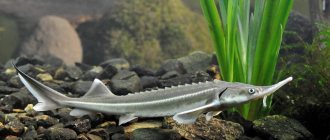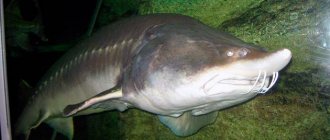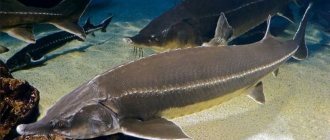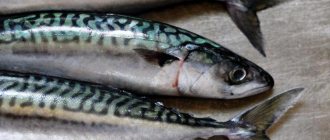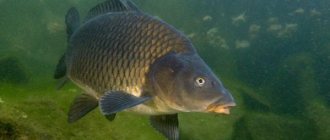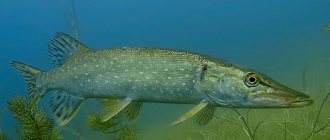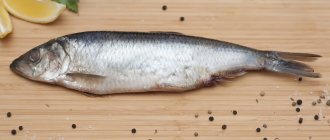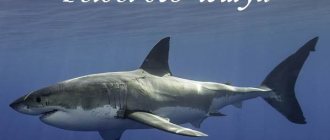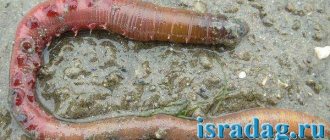Sturgeon have always been valued by humans due to the taste of their tender meat and the value of their caviar. This is confirmed by finds made by archaeologists. They say that in the 6th century, six-meter belugas were caught in the Moscow River. The habitat of commercial fish is Eurasia and North America. Over 170 million years of development, it has adapted to temperate climate conditions and easily tolerates low water temperatures.
This is interesting.
According to A. Yarkov, a member of the paleontological society of the Russian Academy of Sciences, in the Cretaceous period there was a sturgeon whose size reached 7 meters and weighed 2 tons; its bones were discovered in the Volgograd region.
Where does it live?
Sturgeons stay at a depth of two to one hundred meters, where there is food.
They are anadromous, semi-anadromous, and freshwater. Regardless of habitat, commercial fish eggs develop only in fresh water.
Migrants live in the coastal waters of the seas, and in April-May they ascend the river to spawn, covering long distances against the current. Then the schools of fish return to the sea. Semi-anadromous species are found in the estuarine zones of the sea and spawn in the lower reaches of rivers. Most freshwater fish live and spawn in freshwater bodies of water.
More than ninety percent of the world's sturgeon stock is concentrated in the Azov and Caspian Seas. On the territory of our country, this fish is also found in the Volga, Ural, rivers of Siberia and the Far East.
How long does a sturgeon live and its size?
The sturgeon is a fairly large fish belonging to the class of ray-finned fish, a subclass of cartilaginous ganoids. The high price and uniqueness of representatives of this fish family is directly related to its size, structure and origin. The body length of the sturgeon sometimes reaches six meters, the maximum weight is 816 kg. The weight of the average sturgeon fish going into the fishery ranges from 12 to 16 kg. The structural features of the fish are directly related to its ancient origin.
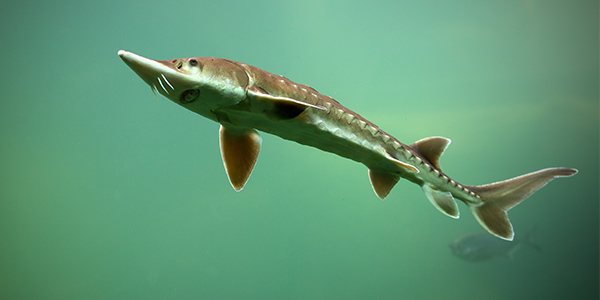
About the structure of sturgeon
The question of how long a sturgeon lives deserves attention and respect. After all, according to experts, the sturgeon family has been living in reservoirs since ancient times, when there were no bony waterfowl in them. This is related to the structural features of the sturgeon’s body.
The fish's skeleton consists of cartilage and does not have a spine. Throughout its life, the sturgeon retains its notochord. The presence of a cartilaginous chord—the basis of the axial skeleton—is directly related to how many years sturgeon lives. The absence of vertebral bodies, according to scientists, indicates its ancient origin, dating back to the times when there were no bony waterfowl in the waters of the earth. Answering the question of how long sturgeon live in the wild, scientists claim that this fish appeared in the Earth’s water bodies back in the Cretaceous period, i.e. about 86-71 million years ago.
The structure of the fish has some interesting features: the body is elongated, devoid of scales, and has a spindle shape. It has five rows of diamond-shaped plate-like scutes. One row located along the ridge contains 10-20 such scutes. The internal skeleton, consisting of cartilage, ends with the skull. The head of the sturgeon is small, the muzzle is cone-shaped and elongated. There are four antennae at the end (no fringe). The mouth is protruding, the lips are rather fleshy, there are no teeth. Sturgeon fry grow small teeth, but over time they fall out.
Self-feeding adult fish
The daily norm of a physiologically developed sturgeon depends on its body weight and conditions of detention. In an artificial pool it is recommended to maintain a constant temperature at +19-+24 degrees. The daily diet of adult fish is 20–25% of its weight.
Adults feed mainly on mixed feed and fortified premixes. Experts advise breaking large granules into small pieces up to 0.3–0.2 mm. The feeding area is cleaned after two hours. If this is not done, the pond will become polluted over time, which will lead to a decrease in oxygen levels.
Sturgeon food can also be homemade. In action are:

Recipes of specialized feeds
- minced fish,
- fish meal or blood meal,
- trembling,
- egg powder,
- premixes.
Spirulina (algae) or chlorella are often added to the base food.
About the external features of sturgeon
Often people are not only unaware of the question of how long sturgeon lives, but they don’t even know what this fish actually looks like. They have to judge this by mainly observing those sturgeon representatives that are exhibited in the aquariums of large specialized stores.
Bone plates in the shape of stars are randomly scattered on the surface of the sturgeon’s body. The pectoral fin is quite rigid, the shape of the anterior ray resembles a spine. On the dorsal fin there are 27-51 rays leading to the caudal fin. The swim bladder is well developed. The color of the sturgeon's body surface is predominantly gray. However, there may be areas of lighter or grayish-black color on the back. The sides are most often brown, the belly is white.
About spawning
Nature lovers often ask: how long does a sturgeon live to produce caviar? The bulk of sturgeon representatives reach sexual maturity quite late - males are ready for spawning at 5 - 18 years, females - at 8 - 21 years. The habitat plays a significant role in the timing of sexual maturation of the fish - the further north the species lives, the later its representatives will begin to reproduce. Spawning of female sturgeon occurs once every three to five years. Spawning migration lasts from early spring to late autumn.
Reasons for disappearance
Back in the 17th-19th centuries, up to 50 thousand tons of sturgeon were caught in the Caspian basin. At the turn of the 19th and 20th centuries, production dropped to 29 thousand tons.
In 2007, commercial fishing was prohibited in the Caspian Sea, and since 2014, the countries of this basin have agreed to end commercial sturgeon fishing.
Such stringent measures were taken to preserve the population of valuable fish.
Ichthyologists name 2 main reasons for the decline in sturgeon numbers.
- Poaching. It has grown by 30% since the early 2000s. No matter how much vandals are fined, they catch sturgeon on an almost industrial scale.
- Reduction of spawning sites due to intensive economic development in river basins.
About the varieties of sturgeon
The sturgeon genus is represented by seventeen species of fish, most of which are on the verge of extinction and are listed in the Red Book. The sturgeons include the following species of fish living in the territory of the former Soviet Union: beluga, kaluga, shovelnose, sterlet, thorn, stellate sturgeon, Atlantic sturgeon, Pacific (Sakhalin), Russian, Persian (South Caspian), Amur, Siberian sturgeon, as well as three species false pathology (large, small and false pathology Fedchenko). The largest of them are discussed later in the article.
Number
This family belongs to the most valuable commercial fish. The most important population is the Caspian. In the middle of the last century, up to 18 thousand tons of Russian sturgeon were caught annually. And at the beginning of the 20th century, the catch reached 40 thousand tons. The decline began after the construction of hydroelectric power stations that blocked the rivers. They cut off the fish's path to spawning grounds. In 1980, the number of sturgeon in the Caspian Sea was estimated at 60 million individuals. Over the next 15 years, it decreased by 3 times and amounted to 20 million individuals. Today, the number of unique fish continues to decrease. This is happening due to renewed sea fishing and poaching.
Siberian sturgeon
This large fish reaches two meters in length. The weight of one individual is about 210 kilograms. The fish is found mainly in Siberian rivers - from the Ob to the Kolyma. In addition, it also lives in the reservoirs of eastern Kazakhstan and Lake Baikal. Representatives of this species live for 60 years. Sometimes Siberian sturgeon are crossed with sterlet, resulting in a fish called koster.
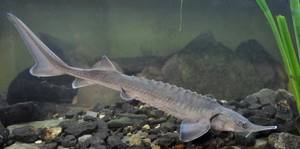
Habitats
Sturgeon can be found in almost every major Russian or Siberian river. In European Russia, in the northern rivers, despite the particular abundance in the Yenisei and Ob, Russian sturgeon. anyway, he is a very rare guest and swims in by accident. Once, near Ust-Tsylma, like a huge curiosity, an Ob sturgeon was caught. This Siberian sturgeon has some differences from sturgeon from the Black Sea or Caspian basins, and Siberian fish can reach a weight of up to 210 kg. The beluga can reach the same gigantic size.
The Volga is considered the most numerous sturgeon; this river rises quite high, and already in the Urals and in the reservoirs of the Black Sea basin, sturgeon is already found in much smaller quantities. Sturgeon are sometimes found in the Volga River up to the city of Rzhev, but after Yaroslavl small sturgeon become quite common, this proves that the fish comes to these areas to spawn.
The sturgeon belongs to the family of migratory fish, like pink salmon, and in the open sea it is a very rare occurrence and tries to stick to river mouths and freshwater parts of the sea; and in the Caspian Lake - its northern part. But, despite this, the bulk of sturgeon live in the Caspian Sea itself. From here, from April, sturgeon begin to swim into rivers to spawn. He most often walks in small schools and tries to stay in the fastest and deepest places in the reservoirs; It swims slower than the sturgeon, but faster than the thorn. From the Dnieper in May the return journey begins, but in the Volga and the Urals the sturgeon remains much longer, and along the Yenisei (along Krivoshapkin) it turns down only by August 25th.
The course of the sturgeon, like all migratory fish, depends on a fair wind: in the opposite wind direction, the fish will crowd near the shallows in front of the mouths and wait for the long-tailed fish to return to the river at the same time as the waves.
The number of sturgeon increases significantly from mid-May. But the fish entering the river at this time no longer spawn here, but remain on the Yatovs for the whole winter and will spawn only a year later. In the Volga, from the city of Rybinsk to the city of Samara, sturgeon spawn almost at the same time as sterlet or a little later - in early May. In the lower reaches of the Volga, near Sarepta and Tsaritsyno, and in the Kura River, sturgeon spawn at the end of June or July (mostly).
Sturgeon spawning is very short and lasts only 3-4 days. Maturation and spawning is a fairly quick process; all eggs ripen simultaneously in each individual fish, and they are all spawned together.
Small sturgeon live for a long time where they hatch from the eggs, and then migrate to the sea, where they remain until they reach puberty - up to five years, or even more. It is not known for certain how long sturgeon live in the river. Most likely, they swim away as soon as they turn one year old, but sometimes two-year-olds are also found in rivers. It is noteworthy that these osterata, as experienced fishermen say, stay in the same flock with sterlet. this suggests that the bulk of young fish go to sea, most likely in the same autumn or during high water, before reaching one year of age.
Young sturgeons at first feed on small crustaceans, and as they mature they begin to eat shells. Shells are the main food of adult sturgeons, which only when they reach a significant size of about 1.5 meters begin to eat other fish.
Unfortunately, despite the extreme fertility of sturgeon, the number of this fish species is significantly decreasing from year to year. Today in the upper Volga, for example, sturgeon is very rare. The main destroyer of sturgeon is man, since predatory fish or birds are dangerous to him only at first. Most often, sturgeon becomes prey for catfish. One of the sturgeon's enemies is the small parasitic crustacean Dibcelestium sturionis. It is found on almost all representatives of sturgeon fish.
Russian sturgeon
This is the first sturgeon species to be artificially bred. It has a high value in the world due to the high quality of caviar and meat. How long does a sturgeon live? The age of representatives of this species is approximately 46 years. Alas, the Russian sturgeon is on the verge of complete extinction. It differs from other species by its short and blunt snout with antennae growing towards its end. The length of an individual can reach two and a half meters, weight is more than 115 kg. The standard weight of a representative of this species does not exceed 12-24 kg.
The diet of the fish depends on its habitat and consists mainly of worms, mysids, crayfish and fish: herring, mullet and shemai. Russian sturgeon is found in almost all large bodies of water in our country. Its main habitat is the Azov, Black and Caspian Seas.
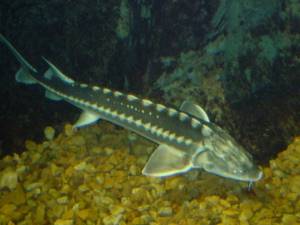
What does it eat?
The diet of sturgeon is influenced by the habitat, type and age of the fish.
The basis of the fry's diet is mainly small plankton: daphnia, bosmina, cyclops. It may remain unchanged for several years. The young individual eats insect larvae, small shrimp, and snails.
The diet of adult sturgeons consists of 85% protein food. They feed on small fish (gobies, trout, sardines), shellfish, aquatic worms, algae (if there is not enough protein food), even small waterfowl.
Before spawning, this commercial fish accumulates nutrients, so it absorbs large amounts of food. What does sturgeon eat during this period? It feeds on everything it can find in the pond:
- crustaceans;
- mussels;
- leeches;
- cladocera;
- algae.
When a sturgeon spawns, it practically stops eating. After spawning it feeds on plants. And after about a month, the appetite is restored, and the fish returns to protein foods.
Beluga
The following question is often asked: how long do sturgeon and beluga live - the largest representative of the sturgeon species?

Beluga is truly impressive with its external parameters. The body length of this fish sometimes reaches five meters, and the beluga weighs more than one ton. It is the beluga that is the longest-lived among all sturgeons, whose age can reach one hundred years. The results of archaeological excavations are known, in which the remains of beluga individuals from the Middle Ages were discovered. Their size exceeded six meters. At that time, fishermen often died if such a giant got into their gear. The Azov beluga reaches sexual maturity earlier than other species: females at the age of 12-14 years, males at the age of 16-18. Other sturgeon species become sexually mature much later - at 14-23 (females) and 17-26 (males) years.
Beluga is considered the most prolific of all sturgeons. The largest individuals lay up to 7.7 million eggs.
Lifespan
It all starts with the egg.
Having reached sexual maturity, sturgeons go to spawn. This period most often begins in spring and ends in November, with a peak in mid-summer. For reproduction, the fish chooses rivers with temperatures from +15 to +20 degrees: at higher temperatures, the eggs die.
For reference. Females spawn once every 3-5 years, males - more often. And after reproduction they do not die like other fish.
Newly born sturgeons hide under stones because they cannot swim or see well. After 10-12 days, when their body length reaches 2 cm. The fry begin to actively feed, swim well, and become similar to adults.
For the first year (in some species - 3-4 years), juveniles live in fresh water or on the border with salt water, since sea water is deadly for them.
The fish grows slowly: large species of sturgeon reach 28-35 cm at two years of age, and about 70 cm at four years of age. Only at the age of 12 do they grow to medium size.
Average lifespan of different species:
- stellate sturgeon – 30 years;
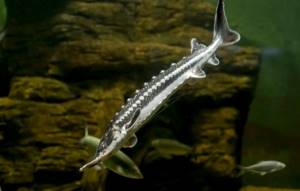
- sturgeon – 50;
- Beluga - up to 100.
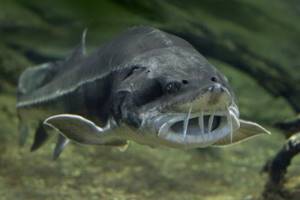
The lifespan of commercial fish is affected by seasonal differences in water temperature, as well as pollution of seas, rivers and lakes.
Sterlet
This fish is the smallest freshwater sturgeon: its length is about 1.2 meters and its weight is up to 16 kilograms. Sterlet is distinguished from other species by the huge number of lateral bugs (over 50), as well as the presence of fringed antennae. Another interesting feature of this fish is the variability of the shape of the snout - it can be sharp and blunt.
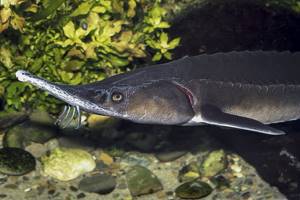
The blunt-snouted sterlet grows much faster, is more plump and fertile than its sharp-snouted sister. A similar difference is also inherent in other freshwater sturgeon - Siberian and Amur.
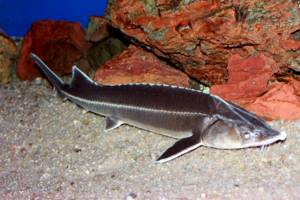
Stellate sturgeon
Like all species of sturgeon, the stellate sturgeon has a number of differences: it is easy to recognize by its rather long sword-shaped snout (over 60% of the length of the head).
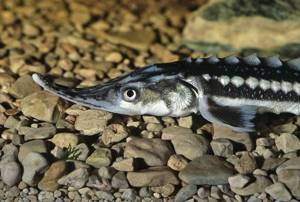
The body length reaches two and a half meters, weight - 80 kg. Stellate sturgeon is the most heat-loving among all migratory species, so it goes to spawn later than others, when the water temperature reaches a more suitable level. This species occupies one of the first places in terms of sturgeon fishing volumes. The most active production of this valuable fish is carried out in the Urals.

Kaluga
The freshwater species of sturgeon is one of the largest. Length – approximately from 3.5 to 5.5 meters, weight – from 300 to 1000 kg. There are specimens of over a ton.
It lives in the rivers of the Amur basin, in the Argun and Sungari at a depth of 50 meters. Migratory river fish rise from the estuary to spawn, while resident fish move low along the river. Kaluga reaches puberty at 18-22 years of age with a length of 230 cm. It spawns in the spring, and in some cases in the fall.
The body is covered with rows of “bugs”, bone grains and large plates. The head has a sharp short conical snout, on the lower part of which there is a large semilunar mouth.
The body is mostly greenish-gray and the belly is white.
The diet in the first year consists of small fish and invertebrates. Adults feed on salmon, chum salmon, and pink salmon. For river Kaluga, bottom fish become food.
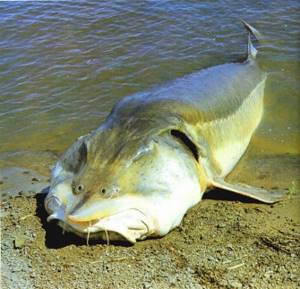
Atlantic sturgeon
This is one of the largest anadromous sturgeon species. The length of the individual reaches three meters in length, and the weight can be over 200 kilograms. On the radically striated surface of the body of the Atlantic island, there are many massive bugs, and the pectoral fin is equipped with a powerful bony ray. Unfortunately, this population, once large, today numbers approximately 1 thousand individuals. The main habitat is the Black Sea basin. Like all sturgeon species, Atlantic sturgeon are of significant commercial value.
About the benefits and harms of sturgeon
The calorie content of sturgeon meat is about 160 kcal calories per 100 g of product. It contains a significant amount of easily digestible proteins, as a result of which this product is digested quite quickly. Sturgeon is often used in various diets due to its rich content of rare acids that are beneficial for the body, vitamins C, PP, B and A, macroelements potassium, calcium, magnesium, phosphorus, as well as sodium, iron, chromium, nickel, iodine and fluorine .
Sturgeon caviar is rich in lipids and protein. The caloric content of caviar exceeds meat in this indicator and amounts to 200 kcal per 100 g of product. Therefore, it is recommended for people to use during the recovery period after suffering serious illnesses.
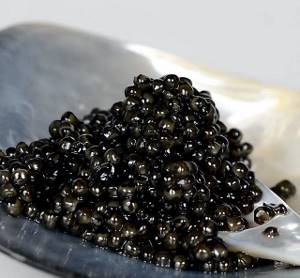
Sturgeon, when eaten regularly, has a beneficial effect on the state of the human cardiovascular system, reduces the risk of myocardial infarction and blood cholesterol levels, promotes the growth and strengthening of bone tissue, as well as improving the condition of the skin.
Despite the fact that the benefits of consuming sturgeon products are obvious, sturgeon meat can still cause significant harm to the body. Sturgeon, as well as caviar, may be contaminated with the causative agent of botulism, so it is necessary to purchase these products only from trusted suppliers. When purchasing, you should pay attention to their smell and appearance.
